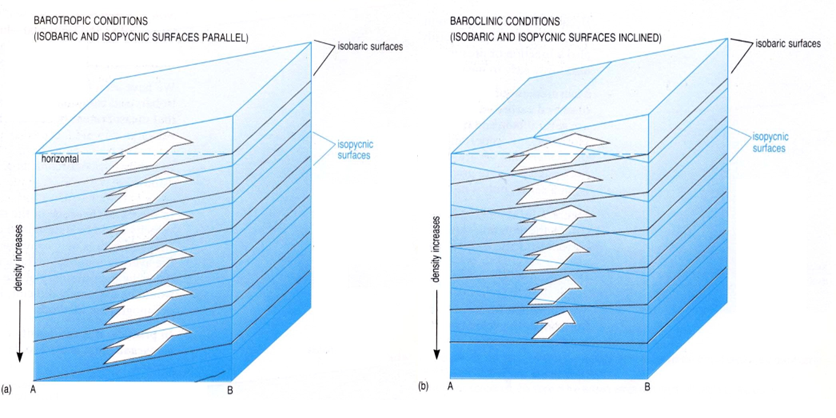Glossary
Many terms that are used in geophysical fluid dynamics (and appear in these tutorials) can be rather esoteric and unfamiliar to many readers. We provide this glossary as a handy reference while you peruse the tutorials, and also to supply a bit of the physical context behind the concepts presented here.
Further resources: The American Meteorological Society’s Glossary of Meteorology is a good resource to explore more definitions and context.
- Annulus – the formal mathematical name for a ring; the shape between two concentric circles.
- Atmosphere – the layers of gases surrounding a planet or other astronomical body and held in place by its gravity.
- Baroclinic fluid – a fluid in which density \(\rho\) does not depend only on pressure \(p\), in other words with intersecting isobars and isopycnals. The opposite of barotropic. Baroclinity is the measure of how baroclinic a fluid is, proportional to \(\mathbf{\nabla}\rho\times\mathbf{\nabla}p\) (the cross product of the density and pressure gradients).
- Barotropic fluid – a fluid in which density \(\rho\) depends only on pressure \(p\) (i.e. \(\rho=\rho(p)\)); in other words, a fluid with parallel isobars and isopycnals and zero baroclinity. The opposite of baroclinic.

Fig. G1. Illustration of barotropic (left) and baroclinic (right) conditions, with density increasing downwards. - Coriolis force – a ‘fictitious’ force acting on objects in motion in a reference frame that rotates relative to an inertial (non-accelerating) frame, equal to \(-2m\mathbf{\Omega}\times\mathbf{v}\), where \(\Omega = 7.3\times10^{-5}\text{ rad s}^{-1}\) is the angular velocity (rotation rate) of the Earth and \(\mathbf{v}\) is the wind speed.
On the Earth, the acceleration experienced by surface air due to the Coriolis effect is given by the horizontal component of the above expression \(a_\mathrm{C} = 2 \Omega v \sin \phi = vf\), where \(\phi\) is the latitude and \(f = 2 \Omega \sin \phi\) is known as the Coriolis parameter. In the absence of other forces, this effect causes winds to deflect to the right of the direction of travel in the northern hemisphere (clockwise motion), and to to the left in the southern hemisphere (anticlockwise motion). Coriolis forces are responsible for cyclones and anticyclones, which respectively rotate anticlockwise and clockwise in the northern hemisphere, and vice versa in the southern hemisphere. - Fluid – a material that deforms (flows) continuously in response to an applied stress or force. In general, this definition applies to liquids and gases, but not solids.
- General circulation model (GCM) – a mathematical model simulating how air circulates in a planet’s atmosphere (or ocean), using the Navier–Stokes equations on a rotating sphere. GCMs are widely used in weather and climate forecasting, and for examining different atmospheric circulation regimes (see Tutorial 3).
- Geostrophic flow – fluid flow in which the pressure-gradient force is balanced by the Coriolis force, with the direction of flow along an isobar.
- Instability – a phenomenon in which small perturbations to an initial flow (strictly speaking a steady, equilibrium flow) tend to grow in strength and amplitude, usually at the expense of the energy (potential or kinetic) of the initial state. Baroclinic instabilities typically grow at the expense mainly of initial potential energy whereas barotropic instabilities grow at the expense mainly of the kinetic energy of the initial state.
- Isobar – a line or surface on a diagram or map connecting points of equal pressure.
- Isopycnal – a line or surface on a diagram connecting points of equal density.
- Meridional flow – fluid flow along lines of longitude (i.e. northerly or southerly). Contrasts with zonal flow. Can also refer to flow projected onto the latitude-height plane e.g. in a meridional overturning circulation.
- Pressure-gradient force – the force experienced by air caused by a difference in pressure across the surface, creating wind down a pressure gradient from an area of high pressure to an area of low pressure.
- Rossby number – a dimensionless number, relating the ratio of inertial forces to Coriolis forces for a given rotating fluid flow, characterising the influence of the Coriolis effect on the flow: \[\mathrm{Ro} = \frac{U}{Lf}\] where \(U\) is the characteristic horizontal velocity scale, \(L\) is the characteristic length scale, and \(f\) is the Coriolis parameter defined above. For the Earth’s rotation to be important, \(\mathrm{Ro}\leq1\).
- Stratosphere – the second layer of the Earth’s atmosphere, above the troposphere, stretching from approximately 6 to 20 km to approximately 50 km above the surface. The stratosphere contains the ozone layer, and temperatures increase with altitude, unlike in the troposphere.
- Troposphere – the first and lowest layer of the Earth’s atmosphere, stretching from the surface up to an altitude of approximately 6 to 20 km, where it meets the stratosphere at the tropopause. The troposphere contains the majority of the atmosphere’s mass, and is where almost all weather occurs.
- Zonal flow – fluid flow along lines of latitude (i.e. easterly or westerly). Contrasts with meridional flow.
